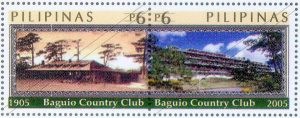Trivia about the Baguio Country Club
In the year 1900 the U.S. Secretary of State Elihu Root ordered the 2nd Philippine Commission “Do not forget to look for that cold place!” The Commission by then had heard of this fabled “paradise” from the Spaniards who were leaving after the Philippines had been purchased from Spain. The cold place was “Kafagway” inhabited by 30 Igorots, 10 llocanos and a white man-a German named Otto Sheerer.
The Americans were in search of a place of relief from the tropical heat that had become unbearable to the white man. Once chartered into a city, this colonial hill station became “Baguio”, a haven of hills and dales, virgin forests, brooks and glen, and that much coveted cool place for rest and recreation.
Governor General William Cameron Forbes ordered in October 10, 1905 D.L.L. McGrew, an assistant of a government architect, William E. Parsons, to start a Country Club to provide recreation for healthy productive living and provide justification for the four million pesos spent for the construction of the Benguet Road.
A part of the cattle pasture land of an Igorot Chief, Mateo Carino became “Governor’s Hill” which was to become the site of the Baguio Country Club And in February 1905, the Baguio Country Club was founded with an initial all-american, all white membership. With fervour and American energy, the clubhouse was built with a three-hole golf course.
After 100 years the club’s story is as rich and as colourful as Philippine History – A story of American annexation, colonialization, democratization, and freedom just as it is of the Filipino’s revolution, heroism, struggles and pursuit for independence. To this day, traces of American influence pervades the Baguio Country Club for its blend of modern, colonial charm now adapted to its ethnic heritage.
And after 100 years, as that “cold place” was discovered, developed and reinvented, a historical transformation has occurred. The “Kafagway” population profile has changed to near half a million into a Baguio for all Filipinos. Also, the Baguio Country Club has seen its many seasons of diminishing Americans, its brief conversion to a Japanese Officers Club, its liberation in 1946 and the emergence of Filipino membership and leadership.
In 1957, a Filipino stockholder, Justice Roman Ozaeta was elected the first Filipino Baguio Country Club president. As General MacArthur would say “Imperialism was buried” and this was shown in the Baguio Country Club. Many Americans fell in love with the club and the country that they opted to stay on while their compatriots have long departed. Others turned Filipino citizens like C.M. Cotterman.
Potenciano llusorio, a lawyer-businessman, succeeded Ozaeta and was elected President in 1972. During his presidency, the strong earthquake of July 16, 1990 changed the landscape of Baguio and the club was structurally damaged. In December of the same year, a fire razed the Club to the ground. Armed with vision, energy, ingenuity and resourcefulness, Mr. llusorio mustered all that he could to build a new and bigger club house which was inaugurated on February 18, 1995, the 90th Anniversary of the Club. With passionate dedication and love for Baguio and the Baguio Country Club, Mr llusorio was adopted as a “citizen of Baguio”.
Baguio Country Club after a hundred years remains a bastion of cordiality if not brotherly love. The story of Baguio Country Club is the history of Baguio herself. And just like Baguio, it is here to stay as a testimony to Filipino resiliency and as a protector of her cultural legacy and heritage.


Recent Comments